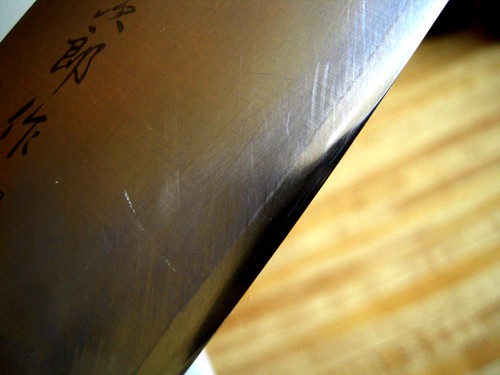
After seeing how well the chefs (at
Konohana, the sousaku-ryori restaurant I worked at last year in Tokyo) and the housewives in Japan take care of their hōchōs (Japanese cutlery), one of the first things I did when I moved back to the U.S. was to get a knife sharpener for my carbon-steel hōchō I purchased in
Kappabashi two years ago. Luckily, a Japanese knife and tool shop called
Hida Tool & Hardware Co., Inc., is a short, less-than-10-minute walk from my Berkeley apartment. The staff showed me a range of water stones that would be ideal for my hōchō and my budget ($50). I ended up purchasing a 1000 grit water stone for $40. If I win the lottery, I hope to invest in a 3000-6000 grit stone (priced at about 3-5 times that of a 1000 grit stone) for a superior, fine finish.
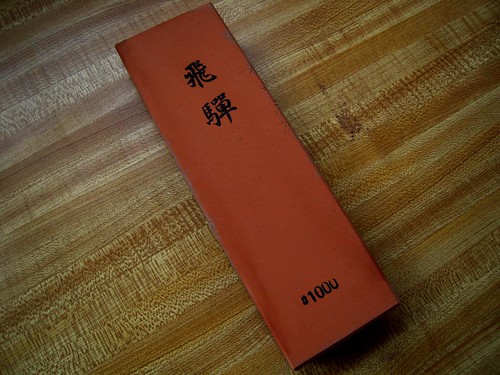
The staff person at Hida Tool took me to the back of the store for a quick demonstration of how to use the water stone for sharpening, which proved very helpful. After sharpening my knife once a week for the past 2 months, I am finally getting the hang of it - using not just my hands and wrists but my whole torso to propel a motion that seems less stressful for both me and my knife. Here's how to sharpen a steel-based knife on a water stone. 1. Soak water stone for
2-3 30 minutes.
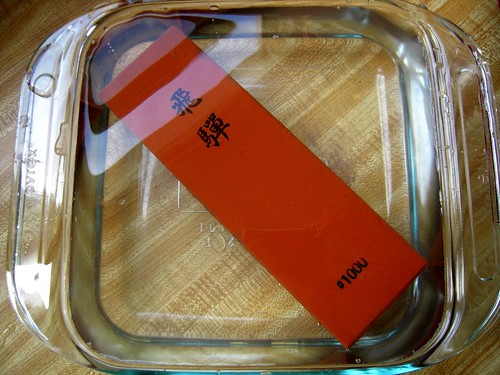
2. Place stone on a wet towel for stabilization. 3. Sprinkle some water on the stone. 4. Sharpen the knife at a 15 degree angle. The Hida Tool knife sharpener said that should be equivalent to stacking two quarters on the non-sharp edge of the blade.
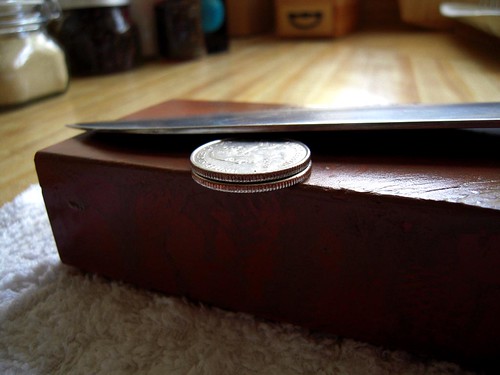
5. With the blade edge towards you,
push the knife away from you at the 15 degree angle. Apply firm but not immense pressure as you push it away from you. Repeat in a rhythmic motion. Once you feel the curled metal of the blade edge, flip the knife over.
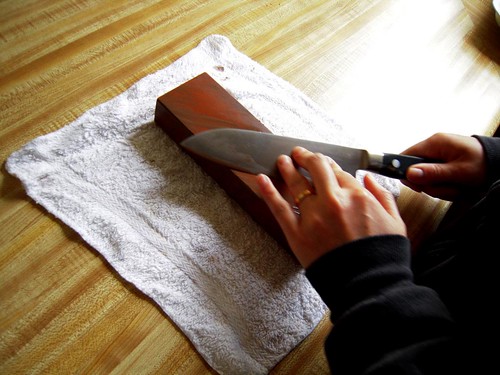
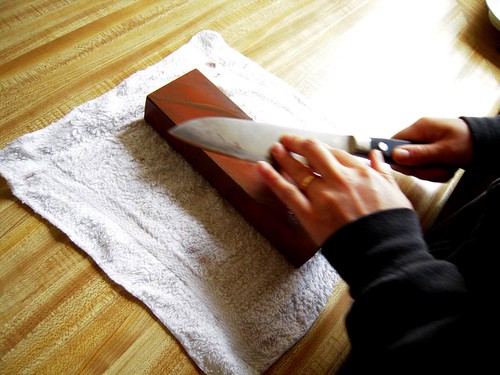
6. With the blade edge away from you,
pull the knife towards you at the 15 degree angle. Again, apply pressure confidently. Repeat in a rhythmic motion.

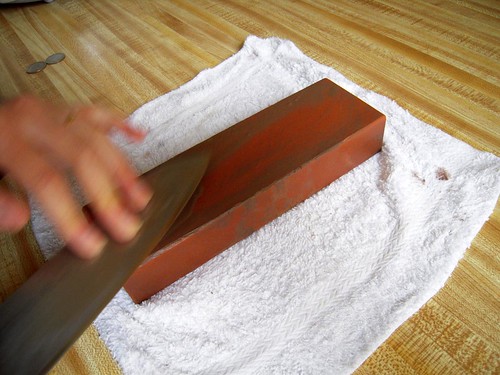
7. After the knife is sharpened, clean the knife and wipe dry. Inspect your beautiful work and test out on a piece of paper (no cardboard) or food.

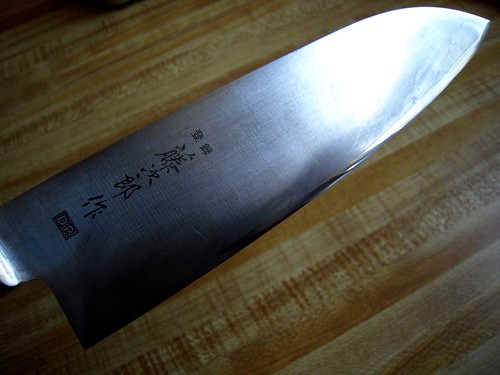
8.
DO NOT clean the water stone after use. The clayish "mud" should be left alone to dry. These fine particles will improve the sharpening performance of your water stone. REVISION: I had the Hida Tools knife master Chika-san review my article and she said to clean the water stone after use. What she did say was to NOT clean it
while you are sharpening the knife. Deep apologies for the misinformation.
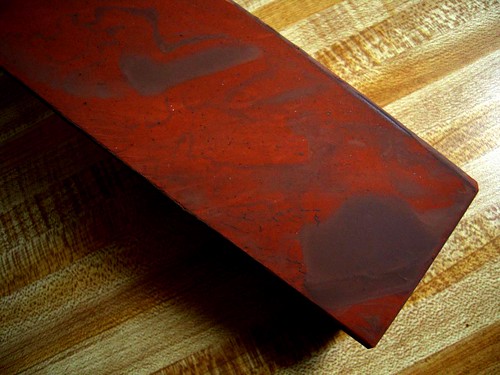
 After seeing how well the chefs (at Konohana, the sousaku-ryori restaurant I worked at last year in Tokyo) and the housewives in Japan take care of their hōchōs (Japanese cutlery), one of the first things I did when I moved back to the U.S. was to get a knife sharpener for my carbon-steel hōchō I purchased in Kappabashi two years ago. Luckily, a Japanese knife and tool shop called Hida Tool & Hardware Co., Inc., is a short, less-than-10-minute walk from my Berkeley apartment. The staff showed me a range of water stones that would be ideal for my hōchō and my budget ($50). I ended up purchasing a 1000 grit water stone for $40. If I win the lottery, I hope to invest in a 3000-6000 grit stone (priced at about 3-5 times that of a 1000 grit stone) for a superior, fine finish.
After seeing how well the chefs (at Konohana, the sousaku-ryori restaurant I worked at last year in Tokyo) and the housewives in Japan take care of their hōchōs (Japanese cutlery), one of the first things I did when I moved back to the U.S. was to get a knife sharpener for my carbon-steel hōchō I purchased in Kappabashi two years ago. Luckily, a Japanese knife and tool shop called Hida Tool & Hardware Co., Inc., is a short, less-than-10-minute walk from my Berkeley apartment. The staff showed me a range of water stones that would be ideal for my hōchō and my budget ($50). I ended up purchasing a 1000 grit water stone for $40. If I win the lottery, I hope to invest in a 3000-6000 grit stone (priced at about 3-5 times that of a 1000 grit stone) for a superior, fine finish.  The staff person at Hida Tool took me to the back of the store for a quick demonstration of how to use the water stone for sharpening, which proved very helpful. After sharpening my knife once a week for the past 2 months, I am finally getting the hang of it - using not just my hands and wrists but my whole torso to propel a motion that seems less stressful for both me and my knife. Here's how to sharpen a steel-based knife on a water stone. 1. Soak water stone for
The staff person at Hida Tool took me to the back of the store for a quick demonstration of how to use the water stone for sharpening, which proved very helpful. After sharpening my knife once a week for the past 2 months, I am finally getting the hang of it - using not just my hands and wrists but my whole torso to propel a motion that seems less stressful for both me and my knife. Here's how to sharpen a steel-based knife on a water stone. 1. Soak water stone for  2. Place stone on a wet towel for stabilization. 3. Sprinkle some water on the stone. 4. Sharpen the knife at a 15 degree angle. The Hida Tool knife sharpener said that should be equivalent to stacking two quarters on the non-sharp edge of the blade.
2. Place stone on a wet towel for stabilization. 3. Sprinkle some water on the stone. 4. Sharpen the knife at a 15 degree angle. The Hida Tool knife sharpener said that should be equivalent to stacking two quarters on the non-sharp edge of the blade.  5. With the blade edge towards you, push the knife away from you at the 15 degree angle. Apply firm but not immense pressure as you push it away from you. Repeat in a rhythmic motion. Once you feel the curled metal of the blade edge, flip the knife over.
5. With the blade edge towards you, push the knife away from you at the 15 degree angle. Apply firm but not immense pressure as you push it away from you. Repeat in a rhythmic motion. Once you feel the curled metal of the blade edge, flip the knife over. 
 6. With the blade edge away from you, pull the knife towards you at the 15 degree angle. Again, apply pressure confidently. Repeat in a rhythmic motion.
6. With the blade edge away from you, pull the knife towards you at the 15 degree angle. Again, apply pressure confidently. Repeat in a rhythmic motion. 
 7. After the knife is sharpened, clean the knife and wipe dry. Inspect your beautiful work and test out on a piece of paper (no cardboard) or food.
7. After the knife is sharpened, clean the knife and wipe dry. Inspect your beautiful work and test out on a piece of paper (no cardboard) or food. 
 8.
8. 




Comments (18)
You can also check the sharpness of the blade (both before and after) on the nail of your thumb. Lower cutting edge at 90 degree angle onto thumbnail and begin to slide it away from you. The more it catches, the sharper it is.
Question, I want to get a one or a set of (depending on the $$$) Japanese knives as a present. Willing to spend $100, which do you a recommend for a beginner?
I finally bought my sharpening stone a couple of months ago, and it is worth every penny. When slicing a tomato easily makes you smile, you should get one. For NYC people, you can buy sharpening stone at Bowery kitchen supply shop in Chelsea Market.
Tomo – I am not a hōchō expert and I am not keen on brands specifically. However, I would recommend the following:
1) For that budget purchase only one. A set for $100 will not be a bargain (in the end) if you are looking for a quality knife.
2) For a beginner, go with a kasumi rather than a honyaki. The honyaki is for a pro and is made entirely out of high carbon steel. Kasumi is made with high carbon steel and is softer. It will be easier to maintain because it’s softer. Also be aware of the shape, the one I have pictured is for an all-purpose diet: for cutting veggies and meats.
3) Know where to buy. Try going to a Japanese knife and tool store. I am sure there is one in LA, just do a search online. They will probably give you the best information if you tell them your purpose and price. I don’t recommend going to Sur la Table. Their demonstrators were much more interested in making a sale on the featured product than to educate you on the selection.
Yamahomo -
I am glad that you second my enthusiasm for a sharpening stone! And thanks for identifying a good cutlery shop. I will check it out next time I am in NYC.
Now, does anyone have a cultery shop recommendation for Tomo in LA?
Thanks Yoko, what great advice. I will look this weekend and start with the Japantown here (Downtown and Sawtelle). Also thanks Yamahomo for the recommendation shoutout! Holler!
What an incredibly in-depth, informative post. Thank you Yoko!
Tomo- my dad bought me a knife a few years ago by a Japanese company called MAC. I am sure it is pretty affordable, and it’s a great knife. Check it out here:
http://www.umamimart.com/2008/05/Jewel-Box-From-My-Pops/
Yoko, I read it closely this time, and I was not aware of step 8 that you are not supposed to clean the stone. Where did you get that? Another question, how do you differenciate sharpening one sided (kataba) verses both sided (ryoba). Almost all of my knives are ryoba, but I just brought the sharpest knives ever from Japan, and I don’t even know if it is one sided or both sided. It looks santoku, so that might be a key.
Yamahomo, yes, regarding step 8, the demonstrator at Hida Tools told me not to wash the stone. When you soak it again for the next use, a lot of the excess gets sloughed off.
Yeah, I think you are right about the kataba and ryoba question you raise. I believe that santoku knives generally have double-beveled edges and therefore, both sides should be sharpened.
Wow, thanks for this post! I’ve been in meaning to figure out how to sharpen my Wusthofs, and whether to do by stone, or take it somewhere. I think I’ve got my answer.